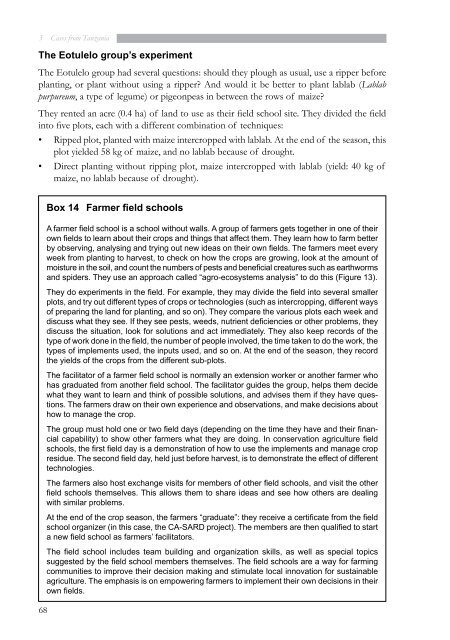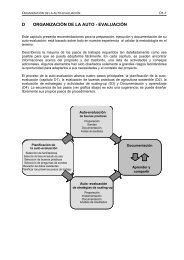cases from tanzania - Sustainet
cases from tanzania - Sustainet
cases from tanzania - Sustainet
Create successful ePaper yourself
Turn your PDF publications into a flip-book with our unique Google optimized e-Paper software.
3 Cases <strong>from</strong> Tanzania<br />
the eotulelo group’s experiment<br />
The Eotulelo group had several questions: should they plough as usual, use a ripper before<br />
planting, or plant without using a ripper? And would it be better to plant lablab (Lablab<br />
purpureum, a type of legume) or pigeonpeas in between the rows of maize?<br />
They rented an acre (0.4 ha) of land to use as their field school site. They divided the field<br />
into five plots, each with a different combination of techniques:<br />
• Ripped plot, planted with maize intercropped with lablab. At the end of the season, this<br />
plot yielded 58 kg of maize, and no lablab because of drought.<br />
• Direct planting without ripping plot, maize intercropped with lablab (yield: 40 kg of<br />
maize, no lablab because of drought).<br />
68<br />
Box 14 Farmer field schools<br />
A farmer field school is a school without walls. A group of farmers gets together in one of their<br />
own fields to learn about their crops and things that affect them. They learn how to farm better<br />
by observing, analysing and trying out new ideas on their own fields. The farmers meet every<br />
week <strong>from</strong> planting to harvest, to check on how the crops are growing, look at the amount of<br />
moisture in the soil, and count the numbers of pests and beneficial creatures such as earthworms<br />
and spiders. They use an approach called “agro-ecosystems analysis” to do this (Figure 13).<br />
They do experiments in the field. For example, they may divide the field into several smaller<br />
plots, and try out different types of crops or technologies (such as intercropping, different ways<br />
of preparing the land for planting, and so on). They compare the various plots each week and<br />
discuss what they see. If they see pests, weeds, nutrient deficiencies or other problems, they<br />
discuss the situation, look for solutions and act immediately. They also keep records of the<br />
type of work done in the field, the number of people involved, the time taken to do the work, the<br />
types of implements used, the inputs used, and so on. At the end of the season, they record<br />
the yields of the crops <strong>from</strong> the different sub-plots.<br />
The facilitator of a farmer field school is normally an extension worker or another farmer who<br />
has graduated <strong>from</strong> another field school. The facilitator guides the group, helps them decide<br />
what they want to learn and think of possible solutions, and advises them if they have questions.<br />
The farmers draw on their own experience and observations, and make decisions about<br />
how to manage the crop.<br />
The group must hold one or two field days (depending on the time they have and their financial<br />
capability) to show other farmers what they are doing. In conservation agriculture field<br />
schools, the first field day is a demonstration of how to use the implements and manage crop<br />
residue. The second field day, held just before harvest, is to demonstrate the effect of different<br />
technologies.<br />
The farmers also host exchange visits for members of other field schools, and visit the other<br />
field schools themselves. This allows them to share ideas and see how others are dealing<br />
with similar problems.<br />
At the end of the crop season, the farmers “graduate”: they receive a certificate <strong>from</strong> the field<br />
school organizer (in this case, the CA-SARD project). The members are then qualified to start<br />
a new field school as farmers’ facilitators.<br />
The field school includes team building and organization skills, as well as special topics<br />
suggested by the field school members themselves. The field schools are a way for farming<br />
communities to improve their decision making and stimulate local innovation for sustainable<br />
agriculture. The emphasis is on empowering farmers to implement their own decisions in their<br />
own fields.




